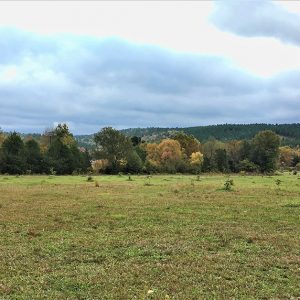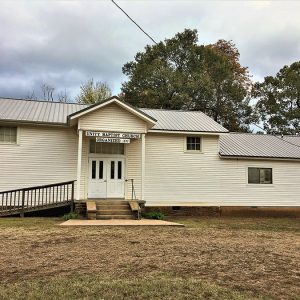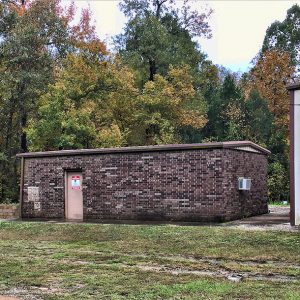calsfoundation@cals.org
Brawley (Scott County)
Brawley is an unincorporated community in western Scott County located near Lake Hinkle. Named for the family who settled in the area, Brawley was established in 1860 at the base of Walker Mountain along Jones Creek, a tributary of the Poteau River. Agriculture and timber have contributed to the economy and way of life in Brawley.
Prior to European exploration, the area surrounding Brawley was an unexplored wilderness. Several species of wildlife that no longer inhabit the area, such as elk and buffalo, were present throughout the region. Numerous archaeological sites and burial mounds are located along the banks of prominent waterways such as the Fourche La Fave and Poteau rivers. Archaeological findings have provided evidence of early inhabitants dating to the Archaic, Woodland, and Mississippian periods. Further archaeological evidence has indicated that the people of the Caddo tribe later inhabited the area.
During the late seventeenth and early eighteenth centuries, French hunters and tradesmen traveled west from the Arkansas Post, exploring portions of western Arkansas. These Frenchmen often traversed rivers and streams throughout the region. Several rivers that flow through Scott County were likely named by these explorers, including the Petit Jean, Poteau, and Fourche La Fave. It is probable that the explorers traveled along the Poteau River or Jones Creek near present-day Brawley.
The majority of settlers began arriving in the area now known as Brawley during the late 1850s. Some of the area’s earliest settlers included the Denton, Brawley, Hays, Brasher, Crawford, Kendricks, and Grey families. The area was settled throughout the early twentieth century.
Brawley Post Office was established in 1860, with George W. Jones as the first postmaster. At the time the post office was established, Brawley was part of Sebastian County. The area was ceded to Sebastian County in 1851 and was not returned to Scott County until 1861. The post office was discontinued in 1868 but reestablished in 1877, with Sarah A. Vise as postmaster.
Men called to fight in the Civil War served with both the Confederacy and Union. Additionally, the women, children, and elderly were left to look after family homes and farms.
After Reconstruction, Brawley grew into a more established community. Vise Cemetery was established circa 1876 near Brawley and named for the Vise family who settled in the area. Oliver Cemetery, established in 1888, is also located near Brawley and named for the Oliver family who settled there.
The 1870 census listed Brawley as one of several townships with an active school. Phillip B. Young was listed as the teacher for the school district. In May 1882, the Scott County Courthouse burned, destroying all records that defined the boundaries of the various school districts that had been established throughout the county. In August, the county court reestablished the boundaries of the fifty-six school districts active in the county, including Brawley School District (Number 25). The school was also known as Fairview and Vise’s School.
By 1885, Brawley had a corn mill, a cotton mill, a cotton gin, two general stores, a blacksmith, a flour mill and gin, two churches, and a school. Two physicians, a constable, and a dentist also resided in Brawley. Unity Baptist Church was organized in 1892. Throughout the late nineteenth and early twentieth centuries, several different general stores, blacksmiths, and mills were located in Brawley.
In 1931, the Brawley Post Office was discontinued permanently; with the mail being sent to Waldron (Scott County).
In 1916, the Bollinger Oil Company began drilling in Brawley, as the increase in road construction and vehicle production caused a need for oil. Oil samples were sent to Waldron from Brawley, but significant amounts were never discovered in the Brawley area.
Several members of the Brawley community served in World War II. The Brawley (Fairview) school district was consolidated with Waldron in 1947.
Agriculture and timber continue to be important to the area. Agriculture exists mostly in the form of cattle and chicken farms. Unity Baptist Church continues to hold services and maintains a supportive congregation in the twenty-first century. Brawley is located on the west side of 960-acre Lake Hinkle, which was completed in 1971 in cooperation with the Arkansas Game and Fish Commission, U.S. Forest Service, and Soil Conservation Service. A rural outpost of the Scott County Telephone Company is located in Brawley.
For additional information:
Cate, Michael. History of Scott County, Arkansas. Dallas, TX: Curtis Media Corporation, 1991.
Echoes: The Scott County Historical and Genealogical Society Quarterly. Waldron, AR: Scott County Historical and Genealogical Society (1986–).
Goodner, Charles. Scott County in Retrospect. Mansfield, AR: Frank Boyd, 1976.
Goodner, Norman. A History of Scott County, Arkansas. Siloam Springs, AR: Bar D Press, 1941.
McCutcheon, Henry Grady. History of Scott County, Arkansas. Little Rock: H. G. Pugh and Company, 1922.
Ty Richardson
Richardson Preservation Consulting
 Brawley Environs
Brawley Environs  Scott County Map
Scott County Map  Unity Baptist Church
Unity Baptist Church  Waldron Telephone Co.
Waldron Telephone Co. 



Comments
No comments on this entry yet.